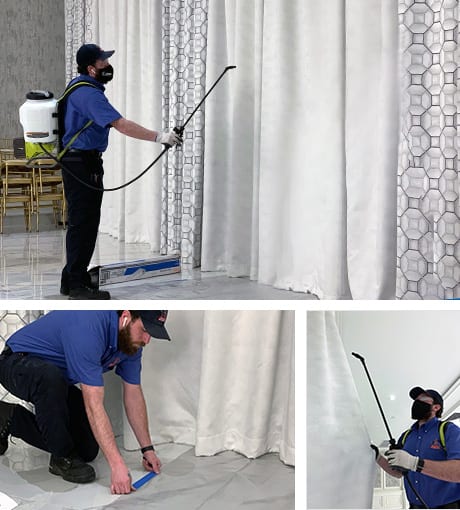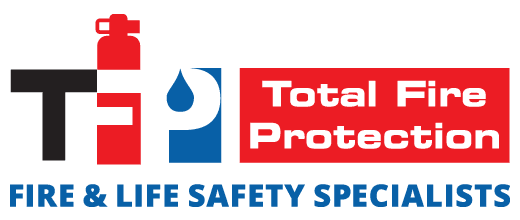- Flameproofing services are essential to slow ignition and flame spread in draperies, fabrics, scenery, and décor, ensuring compliance and occupant safety.
- Certified inspections during Fire Prevention Month help verify that all required materials have been treated, documented, and tested to NFPA standards.
- Sprinkler system readiness requires NFPA 25-compliant inspections of heads, valves, flow switches, drains, and water pressure in dry or pre-action zones.
- Specialized suppression systems such as clean agent, kitchen, and pre-action systems must be tested and maintained to prevent failure in sensitive environments.
- Comprehensive documentation is as critical as physical systems, ensuring AHJ approval, insurance compliance, and audit readiness.
- Seasonal preparation protects sprinkler pipes, valves, and heating systems from winter-related failures that can compromise fire protection.
Every October, Fire Prevention Month serves as a critical reminder for facility managers and safety directors to take stock of their building’s fire protection systems. But this annual observance is more than symbolic. It presents a practical opportunity to identify vulnerabilities, verify compliance, and prepare for the increased fire risks that accompany colder weather and heating system use. In an environment of evolving fire codes and complex occupancy demands, proactive inspection is not just advisable; it is essential to maintaining operational continuity and occupant safety.
This fire prevention checklist is designed to support a methodical, system-wide audit across key fire and life safety categories. From structural defenses to specialized suppression systems and code documentation, each section reflects the expertise Total Fire Protection brings to commercial and institutional properties throughout New York City and the Tri-State Area. By focusing on system integration, real-world risk factors, and code-aligned performance, this guide equips facility leaders to move from reactive compliance toward strategic prevention.
Combustible Materials That Escalate Risk: Why Flameproofing Is Foundational
 Even the most advanced fire protection systems can be undermined by small oversights. One of the most commonly missed risks involves untreated draperies, decorative fabrics, and other combustible materials. These items, often found in theaters, schools, hotels, restaurants, and commercial buildings, can rapidly accelerate a fire if not properly treated with certified flameproofing solutions.
Even the most advanced fire protection systems can be undermined by small oversights. One of the most commonly missed risks involves untreated draperies, decorative fabrics, and other combustible materials. These items, often found in theaters, schools, hotels, restaurants, and commercial buildings, can rapidly accelerate a fire if not properly treated with certified flameproofing solutions.
Flameproofing services apply fire-retardant materials that significantly slow ignition and flame spread, helping to preserve critical evacuation time and support the work of suppression systems. Over time, however, untreated or improperly maintained fabrics and decorative elements can become a hidden hazard. During Fire Prevention Month, Total Fire Protection recommends a thorough review of all soft goods and materials in public assembly areas, auditoriums, hospitality spaces, and tenant facilities. Our certified technicians provide on-site inspections, apply Class “A” and “B” coatings, perform flame tests, and issue affidavits of compliance to ensure materials meet NFPA standards and AHJ expectations.
Passive Defense That Buys Time: Evaluating Your Flameproofing Program
Flameproofing is a passive safeguard that protects occupants by ensuring that textiles, draperies, and decorative elements resist ignition and slow fire growth. By reducing available fuel sources, flameproofing extends the time available for safe evacuation and gives suppression systems the chance to operate effectively.
However, flameproofing can degrade due to wear, exposure, or environmental conditions. Fabrics may lose treatment over time, scenery and displays may be replaced without proper coating, and temporary installations may bypass required safety measures.
Fire Prevention Month is the right time to evaluate:
- The condition of draperies, curtains, and decorative elements in public and tenant spaces
- Whether all required materials have been properly treated and certified
- Expired or missing flameproofing affidavits required by AHJs
- Areas of noncompliance in high-occupancy or assembly spaces
Total Fire Protection offers certified flameproofing services across all industries, including hospitality, entertainment, healthcare, education, and commercial facilities. Our technicians deliver treatment, documentation, and field testing that ensure compliance and readiness.
Sprinkler Systems That Don’t Miss a Beat: Inspection, Testing, and Violation Removal
Automatic sprinkler systems remain one of the most effective means of fire suppression, but only if they are tested and maintained on schedule. Even small issues such as closed valves, corroded heads, or impaired water flow can result in system failure during a fire.
An NFPA 25-compliant inspection during Fire Prevention Month should include:
- Visual inspection of all sprinkler heads for corrosion, obstruction, or paint
- Verification that valves are open, monitored, and sealed
- Testing of water flow switches, tamper switches, and main drains
- Evaluation of pressure in dry or pre-action systems
- Documentation of previous repairs or violations and steps taken to resolve them
Total Fire Protection’s team of licensed master fire suppression piping contractors performs full inspections, testing, and violation removal. Whether your facility is a retail space, healthcare center, office building, or manufacturing site, we ensure your systems are ready to operate under real-world fire conditions.
Specialized Systems That Require Special Attention: Suppression Systems and Agent Readiness
Many critical spaces are not suited for water-based suppression. Server rooms, kitchens, control rooms, and areas with sensitive electronics require dedicated fire suppression solutions designed to activate without collateral damage.
Suppression system readiness should be evaluated with the same rigor as sprinkler systems. For Fire Prevention Month, review:
- Clean agent systems for correct agent levels, no leaks, and operational control panels
- Kitchen fire suppression systems for nozzle alignment, fusible link replacement, and grease buildup
- Pre-action systems for proper sequence logic, detection calibration, and dry pipe pressurization
- Pressure tanks, gas shutoffs, and releasing mechanisms for mechanical reliability
These systems must also be tested in accordance with NFPA and AHJ requirements, including semi-annual inspections and annual performance evaluations. Total Fire Protection specializes in inspecting and servicing both pre-engineered and engineered suppression systems across all industry verticals.
Compliance Begins with Clarity: Organizing Your Fire Protection Documentation
Even if your physical systems are performing as expected, missing or incomplete documentation can derail compliance. During inspections, insurance reviews, or audits by the FDNY or other authorities, your paperwork is often the first point of evaluation.
Fire Prevention Month is the time to:
- Review logbooks for sprinkler, firestop, fireproofing, and suppression inspections
- Organize documentation by system type, test date, technician, and certification
- Archive copies of manufacturer specifications for suppression agents and flame-retardent materials
- Confirm that all violation corrections are recorded with dates and clearance notices
- Maintain permits, work orders, and AHJ approvals in a centralized, easily retrievable location
Total Fire Protection helps clients consolidate services and streamline reporting. Our clients receive centralized access to documentation, reducing administrative burden and improving audit readiness.
Preparing for Winter and Elevating Your Fire Prevention Strategy
The transition into winter introduces new challenges that must be addressed before freezing temperatures arrive. As heating systems go into full operation and reliance on electrical infrastructure increases, the potential for fire-related incidents grows. At the same time, cold weather threatens the functionality of key fire protection components, particularly sprinkler pipes, control valves, and other exposed mechanical systems that may be vulnerable to freezing or failure.
To mitigate these risks, facility teams should insulate piping in unconditioned spaces, test heating systems near suppression equipment, inspect antifreeze loop concentrations, and verify that emergency lighting remains visible during outages. A seasonal review also helps identify areas where cold weather could lead to pipe bursts, valve malfunctions, or electrical hazards, particularly in older or retrofit buildings.
Total Fire Protection offers dedicated pre-winter assessments to help facility managers correct seasonal vulnerabilities before they escalate into mid-season failures. These services form a critical part of a larger fire prevention strategy that moves beyond basic compliance and supports long-term operational resilience. Fire Prevention Month is not just a campaign; it is a call to elevate your facility’s fire protection posture through informed, proactive action. Whether you oversee a commercial office, hospital, distribution center, or educational campus, Total Fire Protection delivers the technical precision and regulatory expertise required to safeguard complex environments.
